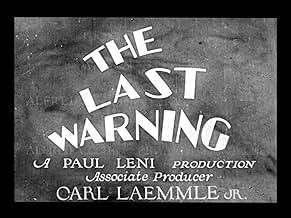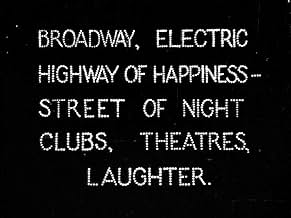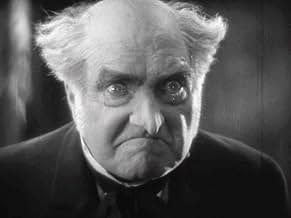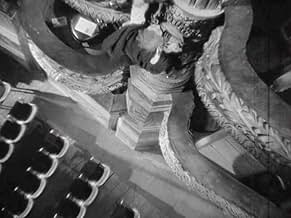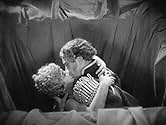Aggiungi una trama nella tua linguaA producer decides to reopen a theater, that had been closed five years previously when one of the actors was murdered during a performance, by staging a production of the same play with the... Leggi tuttoA producer decides to reopen a theater, that had been closed five years previously when one of the actors was murdered during a performance, by staging a production of the same play with the remaining members of the original cast.A producer decides to reopen a theater, that had been closed five years previously when one of the actors was murdered during a performance, by staging a production of the same play with the remaining members of the original cast.
- Regia
- Sceneggiatura
- Star
Carrie Daumery
- Barbara Morgan
- (as Mme. Carrie Daumery)
Slim Summerville
- Tommy Wall
- (as 'Slim' Summerville)
Bud Phelps
- Sammy
- (as 'Buddy' Phelps)
Charles K. French
- Doctor
- (non citato nei titoli originali)
Pat Harmon
- Cop
- (non citato nei titoli originali)
Francisco Marán
- Jeffries
- (non citato nei titoli originali)
Recensioni in evidenza
German director Paul Leni (1885-1929), almost a century after his death, is finally getting the recognition he deserves. His 4 most important films are now available on home video with the last two in quality Blu-Ray/DVD editions from Flicker Alley. For the record the films are 1) WAXWORKS (made in Germany in 1924) and the 3 surviving Hollywood films, THE CAT AND THE CANARY (1927), THE MAN WHO LAUGHS (1928), and THE LAST WARNING (1929). A fourth Hollywood film, the early Charlie Chan mystery THE CHINESE PARROT, is still considered lost.
While these movies had been around awhile for people to see, they were usually in substandard, low budget VHS editions. With the dawn of the 21st century came DVD versions of the first 3 films which allowed these movies to be viewed as they should be with restored visuals, correct running speed, and a proper soundtrack. This confirmed what only still photos had shown before, that Leni was a master of settings, lighting, and cinematography and provided the blueprint for the classic Universal horror films of the 1930s.
THE LAST WARNING was meant to cash in on the huge success of THE CAT AND THE CANARY. Instead of an old dark house, it's an old dark theater which gives Leni the opportunity to indulge in a number of stylistic tricks borrowed from German Expressionism and especially F. W. Murnau. 2 of the performers, Montague Love and Mack Swain, even bear a striking resemblance to Emil Jannings. Laura La Plante is back as the heroine along with a masked killer whose identity is not revealed until the final 10 minutes.
THE LAST WARNING's weakest element is its storyline. It's a pretty good mystery until the final revelation which really doesn't make a whole lot of sense but then its the visual flair that matters the most to us today. Thanks to Universal's new 4K restoration that flair positively jumps out at us from the film's opening Broadway montage to the finale shot from the killer's POV as he swings on a rope. The restoration is a composite print taken from 2 different sources. There are a few rough places but overall it looks great for a 90 year old film.
It takes more than a visual restoration to make a silent film successful. It also needs a music score to accompany the visuals in such a way as to enhance them. In the previous two reviews for this release, one reviewer loved the score while the other positively hated it. While I agree with the latter that the Flicker Alley Mary Pickford scores are rather inappropriate, I lean more toward the former in that, while not finding the score as great as he says, I found nothing objectionable as this movie is light entertainment not a heavy drama.
In summary I find this, along with FA's simultaneous release of Paul Leni's THE MAN WHO LAUGHS, to be another triumph for Flicker Alley. In addition to the best looking prints that we have ever seen, both releases come with numerous extras including a short video documentary on director Leni along with a 24 page booklet full of photos and background info. Now if FA can only persuade Universal to do a 4K restoration on the the original 1925 release of THE PHANTOM OF THE OPERA, the Universal silent horror collection would be complete...For more reviews visit The Capsule Critic.
While these movies had been around awhile for people to see, they were usually in substandard, low budget VHS editions. With the dawn of the 21st century came DVD versions of the first 3 films which allowed these movies to be viewed as they should be with restored visuals, correct running speed, and a proper soundtrack. This confirmed what only still photos had shown before, that Leni was a master of settings, lighting, and cinematography and provided the blueprint for the classic Universal horror films of the 1930s.
THE LAST WARNING was meant to cash in on the huge success of THE CAT AND THE CANARY. Instead of an old dark house, it's an old dark theater which gives Leni the opportunity to indulge in a number of stylistic tricks borrowed from German Expressionism and especially F. W. Murnau. 2 of the performers, Montague Love and Mack Swain, even bear a striking resemblance to Emil Jannings. Laura La Plante is back as the heroine along with a masked killer whose identity is not revealed until the final 10 minutes.
THE LAST WARNING's weakest element is its storyline. It's a pretty good mystery until the final revelation which really doesn't make a whole lot of sense but then its the visual flair that matters the most to us today. Thanks to Universal's new 4K restoration that flair positively jumps out at us from the film's opening Broadway montage to the finale shot from the killer's POV as he swings on a rope. The restoration is a composite print taken from 2 different sources. There are a few rough places but overall it looks great for a 90 year old film.
It takes more than a visual restoration to make a silent film successful. It also needs a music score to accompany the visuals in such a way as to enhance them. In the previous two reviews for this release, one reviewer loved the score while the other positively hated it. While I agree with the latter that the Flicker Alley Mary Pickford scores are rather inappropriate, I lean more toward the former in that, while not finding the score as great as he says, I found nothing objectionable as this movie is light entertainment not a heavy drama.
In summary I find this, along with FA's simultaneous release of Paul Leni's THE MAN WHO LAUGHS, to be another triumph for Flicker Alley. In addition to the best looking prints that we have ever seen, both releases come with numerous extras including a short video documentary on director Leni along with a 24 page booklet full of photos and background info. Now if FA can only persuade Universal to do a 4K restoration on the the original 1925 release of THE PHANTOM OF THE OPERA, the Universal silent horror collection would be complete...For more reviews visit The Capsule Critic.
"The Cat and the Canary" (1927) must've been a popular entry in what was already a crowded field of old-dark-house horror comedies in the final years of the silent era. One need look no further for evidence of that fact than this followup film, "The Last Warning," which reunited director Paul Leni and star Laura Le Plante, as well as a couple of the same writers and art director, for a similar spooky murder mystery with the slight novelty that it's set in a theatre this time. Moreover, the next year, following Leni's death, Universal released a talkie remake of "The Cat and the Canary," the now-lost "The Cat Creeps" (1930). (Likewise, "The Last Warning" was later remade as "The House of Fear" (1939), which is the title of the book from which the play and, thus, the films were derived.) Although Leni's two films were based on different plays, it seems that many of these narratives tended to be strikingly similar, with perhaps the stage version of "The Bat" being the originator of the formula, which itself was made twice for the screen by Roland West ("The Bat" (1926) and "The Bat Whispers" (1930)). The other successful Universal property that "The Last Warning" clearly borrows from is "The Phantom of the Opera" (1925) by reusing its auditorium set, and like Gaston Leroux's story, the stage setting of "The Last Warning" features a play-within-a-play structure--offering a self-reflexive twist on the familiar old-dark-house formula.
Personally, although I've been reviewing quite a few of these films lately, I'm not a fan of the formula--at least not until James Whale introduced a more campy sense of humor and more twisted subject matter with "The Old Dark House" (1932). Before that, they tended to be exceedingly silly, relying on characters' fear of ghosts, and the mysteries are hardly interesting, if not appallingly convoluted. That of "The Last Warning" is especially of little concern, with nary a clue offered throughout the proceedings before an intricate resolution clumsily ties everything together in the end. The main point of the construction, though, was to replay the antics of the 1927 film. So, once again, there's a whodunit, the body of which disappears, and a group of suspects are brought together under one roof, where they're excessively scared that a ghost is behind all of the horrors. As in "The Bat" and "The Cat and the Canary," there's a masked menace creeping through hidden passages haunting the place. By employing "The Phantom of the Opera" set, the similarity between these haunted house plays to Leroux's story becomes blatant, as well, with both featuring a masked menace terrorizing its occupants. Unlike Leroux's Phantom, however, this one has no Christine, but rather insists that no play be performed at all.
Like "The Cat and the Canary," Leni's style here goes a long way in at least making them visually appealing. The superimpositions, including kaleidoscopic images, the moving title effects and moving-camera shots stand out. Originally, there were also sound effects and dialogue scenes, making this late silent film a goat gland and offering the additional technical marvelry of sound. More interesting, though, and why I like this a bit more than "The Cat and the Canary" and most of the other early old dark houses is the honesty of the self-reference of how shamelessly this film imitates its predecessors. In it, the same cast and crew are brought back together to perform the same play they performed years ago, when the original murder occurred, and this is essentially what Leni and the rest of the Universal staff were doing in making the film--bringing back the same cast and crew to perform basically the same play they performed years ago. Even where the cast isn't exactly the same in the two films, the different actors mimic some of the same types of the prior one--so much so that I initially thought that at least a couple others besides Le Plante had appeared in "The Cat and the Canary" as well. Appropriately, the play-within-the-play is titled "The Snare," the play itself being a snare to uncover the murderer in the narrative. In fact, the most we ever get of the inner play is from the point-of-views of the producer and stage hands as spectators of the culprit being lured in by their ruse, and not of the actual play performed for the theatre audience, whose perspectives we don't share. But, the real snare is the trap set by the filmmakers to lure audiences back for the same film in a new guise.
(Note: The reduction prints out there for home viewing are horrendous, but there is a restored version that has appeared at festivals. Hopefully, it'll receive a home video release someday like its companion piece, "The Cat and the Canary.")
Personally, although I've been reviewing quite a few of these films lately, I'm not a fan of the formula--at least not until James Whale introduced a more campy sense of humor and more twisted subject matter with "The Old Dark House" (1932). Before that, they tended to be exceedingly silly, relying on characters' fear of ghosts, and the mysteries are hardly interesting, if not appallingly convoluted. That of "The Last Warning" is especially of little concern, with nary a clue offered throughout the proceedings before an intricate resolution clumsily ties everything together in the end. The main point of the construction, though, was to replay the antics of the 1927 film. So, once again, there's a whodunit, the body of which disappears, and a group of suspects are brought together under one roof, where they're excessively scared that a ghost is behind all of the horrors. As in "The Bat" and "The Cat and the Canary," there's a masked menace creeping through hidden passages haunting the place. By employing "The Phantom of the Opera" set, the similarity between these haunted house plays to Leroux's story becomes blatant, as well, with both featuring a masked menace terrorizing its occupants. Unlike Leroux's Phantom, however, this one has no Christine, but rather insists that no play be performed at all.
Like "The Cat and the Canary," Leni's style here goes a long way in at least making them visually appealing. The superimpositions, including kaleidoscopic images, the moving title effects and moving-camera shots stand out. Originally, there were also sound effects and dialogue scenes, making this late silent film a goat gland and offering the additional technical marvelry of sound. More interesting, though, and why I like this a bit more than "The Cat and the Canary" and most of the other early old dark houses is the honesty of the self-reference of how shamelessly this film imitates its predecessors. In it, the same cast and crew are brought back together to perform the same play they performed years ago, when the original murder occurred, and this is essentially what Leni and the rest of the Universal staff were doing in making the film--bringing back the same cast and crew to perform basically the same play they performed years ago. Even where the cast isn't exactly the same in the two films, the different actors mimic some of the same types of the prior one--so much so that I initially thought that at least a couple others besides Le Plante had appeared in "The Cat and the Canary" as well. Appropriately, the play-within-the-play is titled "The Snare," the play itself being a snare to uncover the murderer in the narrative. In fact, the most we ever get of the inner play is from the point-of-views of the producer and stage hands as spectators of the culprit being lured in by their ruse, and not of the actual play performed for the theatre audience, whose perspectives we don't share. But, the real snare is the trap set by the filmmakers to lure audiences back for the same film in a new guise.
(Note: The reduction prints out there for home viewing are horrendous, but there is a restored version that has appeared at festivals. Hopefully, it'll receive a home video release someday like its companion piece, "The Cat and the Canary.")
Essentially this is part "Cat and the Canary" and part "Phantom of the Opera" - also silent Universal properties. It has some slack parts but the visual atmosphere helps to cover them up, and it has some very inventive title cards where the writing may be initially blurry and come into focus, or the writing may start up clear and then appear to melt down the page, or it may appear to be underwater.
The film is about an actor, John Woodford, in a theatre on Broadway, who dies suddenly when he gets to the part of the play where he is backed into the fireplace by another actor and picks up a candlestick. The lights go out, and when they come back on there is Woodford dead on the floor. The police come to question everybody who was present, then Woodford's body disappears before the coroner gets there. It is discovered by the police that Woodford and another actor, Richard Quayle (John Boles) were arguing in actress Doris Terry's (Laura LaPlante's) dressing room, and both were suitors of hers.
So without a body, the investigation cannot go on, the theatre is closed, and the papers are shown having a field day with the "love triangle" that is insinuated to have something to do with the killing. Several years later, Woodford's close friend (Montagu Love as Arthur McHugh) decides to reopen the theatre with the same cast as the night of the killing and the same play. Why does the entire cast return? Because to not return would make them look guilty.
But somebody does not want the play to open. Heavy scenery comes crashing down. Smoke bombs go off. Threatening letters are written to members of the cast that they perform at their peril, and some mysterious masked figure is running and jumping about the place and even stealing Doris' purse and putting her personal possessions in strategic places to make her look like she is in on all of the strange happenings. Is it the ghost of John Woodford trying to avenge himself? Well of course not. But it might be the real John Woodford, having faked his own death, and still mad at Boles and LaPlante for his romantic rejection. Watch and find out what is behind all of this.
The visuals are just great here. The opening scene reminds me somewhat of 1929's Broadway with all of the pictures of the Broadway nightlife of 1929. Also, the theatre, from the outside, looks like the face of some frightening creature complete with eyes, a nose, and mouth. I just wish better prints were available.
The film is about an actor, John Woodford, in a theatre on Broadway, who dies suddenly when he gets to the part of the play where he is backed into the fireplace by another actor and picks up a candlestick. The lights go out, and when they come back on there is Woodford dead on the floor. The police come to question everybody who was present, then Woodford's body disappears before the coroner gets there. It is discovered by the police that Woodford and another actor, Richard Quayle (John Boles) were arguing in actress Doris Terry's (Laura LaPlante's) dressing room, and both were suitors of hers.
So without a body, the investigation cannot go on, the theatre is closed, and the papers are shown having a field day with the "love triangle" that is insinuated to have something to do with the killing. Several years later, Woodford's close friend (Montagu Love as Arthur McHugh) decides to reopen the theatre with the same cast as the night of the killing and the same play. Why does the entire cast return? Because to not return would make them look guilty.
But somebody does not want the play to open. Heavy scenery comes crashing down. Smoke bombs go off. Threatening letters are written to members of the cast that they perform at their peril, and some mysterious masked figure is running and jumping about the place and even stealing Doris' purse and putting her personal possessions in strategic places to make her look like she is in on all of the strange happenings. Is it the ghost of John Woodford trying to avenge himself? Well of course not. But it might be the real John Woodford, having faked his own death, and still mad at Boles and LaPlante for his romantic rejection. Watch and find out what is behind all of this.
The visuals are just great here. The opening scene reminds me somewhat of 1929's Broadway with all of the pictures of the Broadway nightlife of 1929. Also, the theatre, from the outside, looks like the face of some frightening creature complete with eyes, a nose, and mouth. I just wish better prints were available.
This movie pops up on ebay once in a while and for fans of mystery or horror films, particularly those of Universal, this is a must.
The plot is unimportant - it is about a haunted old theater where an old Broadway play is being brought back despite threats from the ghost of a dead actor.
This film was the last directed by the great Paul Leni. It is really the work of a virtuoso working at his peak. It has everything The Cat and the Canary had and more. The version that seems to be relatively available on video has a good music track too, but unfortunately it seems that the experimental sound sequences the film originally contained have not survived.
Nevertheless, we are lucky that this film has survived as it is such a joyous romp of horror cliches with inventive, wild camera moves and stunning lighting and spooky set design. It foreshadows the great horror classics that were less than two years away for Universal. It is just wonderful filmmaking from a forgotten great director who was at his peak, so if you are into old dark house mysteries or Universal horror movies - FIND IT! - It is one of the best!
8/10 - even better than The Cat and the Canary.
The plot is unimportant - it is about a haunted old theater where an old Broadway play is being brought back despite threats from the ghost of a dead actor.
This film was the last directed by the great Paul Leni. It is really the work of a virtuoso working at his peak. It has everything The Cat and the Canary had and more. The version that seems to be relatively available on video has a good music track too, but unfortunately it seems that the experimental sound sequences the film originally contained have not survived.
Nevertheless, we are lucky that this film has survived as it is such a joyous romp of horror cliches with inventive, wild camera moves and stunning lighting and spooky set design. It foreshadows the great horror classics that were less than two years away for Universal. It is just wonderful filmmaking from a forgotten great director who was at his peak, so if you are into old dark house mysteries or Universal horror movies - FIND IT! - It is one of the best!
8/10 - even better than The Cat and the Canary.
THE STORY & (Pseudo)GENRE -- PHANTOM OF THE OPERA meets CAT AND THE CANARY (also by director Leni). Bizarre visuals liven up the nonsense.
THE VERDICT -- Fast-paced even at 78 minutes. Plenty of old-time thrills and smiles.
FREE ONLINE -- Yes. The ubiquitous orange-tinted print (77 minutes), but also the newer BD upgrade (78 minutes), can be found. Silent with music and effects. I have never seen an 89-minute version, as advertised by IMDB.
THE VERDICT -- Fast-paced even at 78 minutes. Plenty of old-time thrills and smiles.
FREE ONLINE -- Yes. The ubiquitous orange-tinted print (77 minutes), but also the newer BD upgrade (78 minutes), can be found. Silent with music and effects. I have never seen an 89-minute version, as advertised by IMDB.
Lo sapevi?
- QuizSets from Il fantasma dell'opera (1925) used.
- ConnessioniFeatured in Universal Horror (1998)
I più visti
Accedi per valutare e creare un elenco di titoli salvati per ottenere consigli personalizzati
- How long is The Last Warning?Powered by Alexa
Dettagli
- Data di uscita
- Paese di origine
- Lingua
- Celebre anche come
- Sista varningen
- Luoghi delle riprese
- Aziende produttrici
- Vedi altri crediti dell’azienda su IMDbPro
- Tempo di esecuzione1 ora 29 minuti
- Colore
- Mix di suoni
Contribuisci a questa pagina
Suggerisci una modifica o aggiungi i contenuti mancanti

Divario superiore
By what name was The Last Warning (1928) officially released in India in English?
Rispondi

